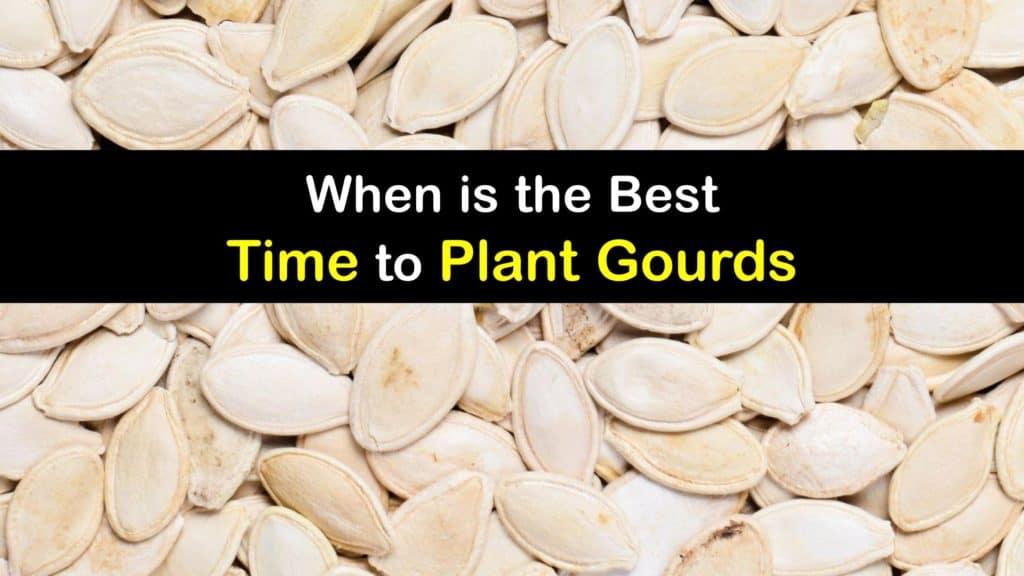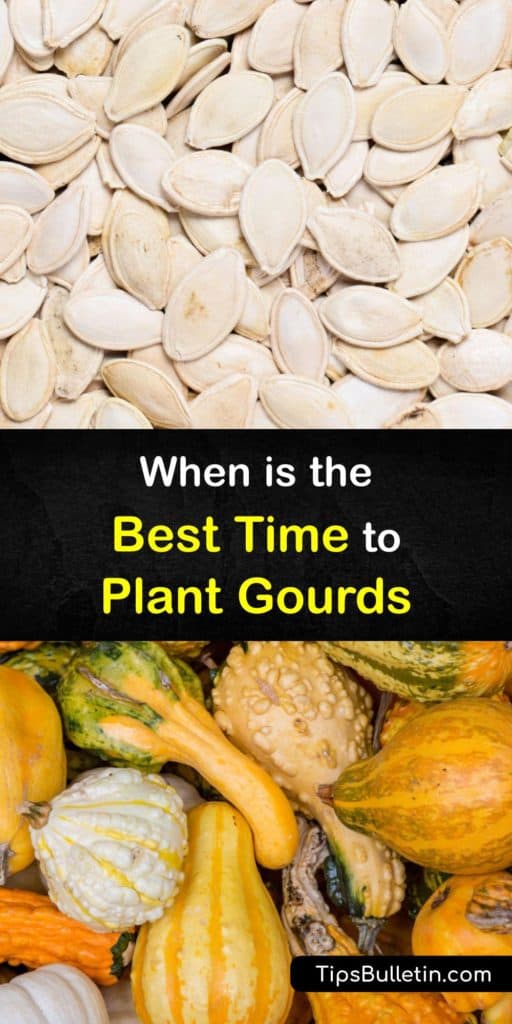Growing gourds in your garden is a fun and rewarding endeavor. There are numerous gourd varieties available to plant, both edible and ornamental. In this article, learn all about when to plant gourds in your USDA planting zone.
Gourds are a warm-weather crop and grow best when temperatures are between 70-85℉ during the day and don’t drop below 50℉ at night. They’re native to Africa, where they’ve been cultivated for food, utensils, storage containers, and musical instruments for thousands of years.
In addition to their warm temperature requirements, the gourds growing season is relatively long. Depending on the variety, gourds take 75-130 days from planting seeds to harvest time. Most growers in northern climates start seeds indoors several weeks before their expected last frost date.

How Long is the Gourds Growing Season?
Timing is crucial for growing a successful gourd crop. From edible varieties like the calabash or bottle gourd to ornamental gourds like angel wing or gooseneck, be sure to give them plenty of time to reach maturity before the fall frost arrives.
Gourds belong to the Cucurbitaceae plant family, also known as cucurbits. They’re closely related to cucumbers, melons, pumpkins, and squash. Soft-shell gourds belong to the Cucurbita genus, while hard-shell gourds are in the genus Lagenaria.
Choose a location for planting gourds with full sun and nutrient-rich, well-draining soil. Use mulch to insulate the soil, hold moisture, and minimize weed growth.
Are gourds fruit? Technically, they are. Although gourd vines grow quickly, their fruits take quite a while to mature. In general, gourd plants begin flowering around ten weeks after seed germination. After the flowers are pollinated, it’ll be another month or two before the gourds are ready to harvest.
Gourd vines often grow over ten feet long, so growing gourds on a trellis makes sense. Grow-gourds on a trellis to save garden space and yield more uniformly-shaped gourds since they’re not lying on the ground. Otherwise, prune your gourd vines as needed to control their sprawling growth habit.

Like winter squash, gourds are harvested in the fall when the vines have died back. After harvesting, cure them to harden the rind and seal the cut stem for storage. Hard-shell gourds keep indefinitely when dried correctly.
Various types of gourds have different drying times. Soft-shell gourds cure in several weeks, while hard-shell gourds usually take four to six months to completely dry.
When to Plant Gourd Seeds
When to plant gourd seeds of if you are growing spaghetti squash plant depends on your climate. The best time to plant spaghetti squash seeds and most gourds is to direct-sow seeds a week or two after the last danger of frost passes and the soil temperature is consistently above 70℉ if your area has a long growing season. This is also pumpkin planting season if you want to pick your pumpkins in the fall.
Otherwise, start seeds indoors four to six weeks before your region’s last frost date. For reference, when to plant gourds in zone 5 should be about four weeks earlier than when to plant gourds in zone 7.
Sow gourd seeds one inch deep, then loosely cover them with soil. Gently mist the soil to saturate. Cover the seedling tray or peat pots with a humidity dome or plastic wrap to retain moisture if you’re starting seeds indoors.
Germination usually takes five to ten days for most of the vegetables to plant in June as well as gourds. The ideal soil temperature for germinating gourd seeds is between 80-85°F.
Gourd seeds don’t germinate below 65°F. Use a heated mat to keep the soil consistently warm during germination. For direct-sowing gourd seeds outdoors, cover your planting area with dark-colored mulch or black plastic for a few days ahead of planting to warm the soil.
When to Plant Gourds Outdoors
The best time to plant gourds varies based on your USDA hardiness zone. In most northern zones, the gourds growing season usually begins in late May or early June, after the last danger of frost passes.
Many gardeners in the south-eastern United States wait to plant gourds until late June or early July to avoid crop damage from squash vine borers. They’re moth larvae that burrow into the lower stems of young squash plants to feed after hatching. The adult moths lay eggs from late spring to mid-summer.
Hard-Shell vs Soft-Shell Gourds
Hard-shell gourds are durable and have a long shelf life. They often get turned into a birdhouse, bowl, dipper, or musical instrument.
They usually have white flowers, and the shell turns from light green to dark green, tan, or brown as the gourd ripens. Some gourd species are edible when harvested before the rind hardens. This is one way to tell the difference between gourds and squash.
Lagenaria siceraria, also known as birdhouse gourds, calabash, or bottle gourds, are the best-known of the genus. Other examples of hard-shell gourds include dipper, penguin, powderhorn, and speckled swan gourds.
Some soft-shell gourds also get dried and stored or used for projects. They typically produce yellow flowers and are more irregularly shaped than hard-shell gourds, sometimes growing bumps or “warts.” They come in diverse colors, shapes, and sizes.
Loofah sponges also come from gourds. Luffa aegyptiaca and Luffa cylindrical are the two primary sponge gourds. After curing, the outer rind is scraped away to expose the coarse inner fiber.
How to Cure Gourds
Gourds must be cured to harden the rind and seal the cut stem before storage. If possible, it’s best to cure your gourds outside in the sun for around a week to ten days. In wet weather, cure gourds indoors where it’s warm and dry.
After two weeks, dip your gourds in a diluted bleach solution to kill bacteria and other contaminants. A fully cured gourd feels lightweight, has a hardened rind, and the seeds rattle when shaken.
Solutions for Common Gourd Growing Problems
Gourd plants sometimes suffer from a handful of common pests and diseases. Keeping your plants healthy with appropriate amounts of light, nutrients, and water is their best protection against attacks from pathogens and insects.
Some of the most prevalent gourd pests include aphids, cucumber beetles, squash bugs, and squash vine borers. To combat a severe pest infestation, spray all plant parts with an organic pesticide like neem oil, insecticidal soap, or horticultural oil.
Try this simple recipe for DIY insecticidal soap for an inexpensive and nontoxic pest control solution.
Place all the ingredients in a clean spray bottle and shake well to blend. Add 15-20 drops of citronella, eucalyptus, peppermint, or tea tree essential oil for extra strength.
Use floating row covers to prevent insect pests from laying eggs on the tender seedlings for the first few weeks after transplanting. Uncover your gourd plants for a few hours a day when they start flowering to provide access for pollination. Without help from insect pollinators, hand-pollination is necessary.
However, insecticides also affect beneficial insects like pollinators and predators. Try to target only the badly infested plants and use environmental controls to minimize pest populations whenever possible. Companion plants like bee balm, marigolds, radishes, and tansy repel gourd pests.
Gourd plants are prone to plant diseases like leaf spot, bacterial wilt, and powdery mildew that thrive in warm, damp conditions, and fungal spores frequently spread through water droplets.
Provide adequate air circulation between each plant and water with drip irrigation or a soaker hose to keep the leaves dry. Always sanitize your garden shears and other tools between uses.
It’s a fun and rewarding DIY project to grow your own gourds. If you’re wondering when to plant gourd seeds, check your locally forecasted last frost date. In warm climates, sow seeds directly in your garden once the soil temperature is at least 65℉. Otherwise, start your gourd seeds indoors in early spring.

If you found these gourd growing tips helpful, please share this article about when to plant gourds with your fellow gardeners on Pinterest and Facebook who might need to know when to plant gourds in zone 6.